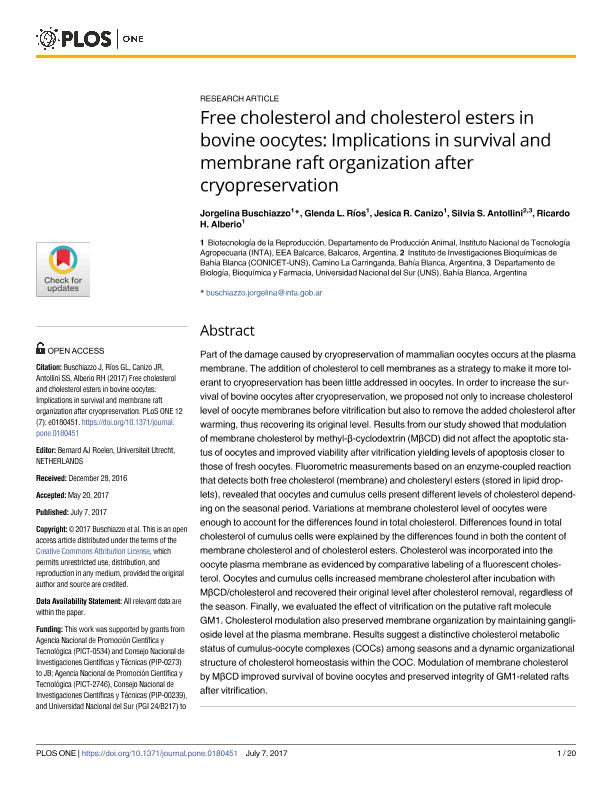Mostrar el registro sencillo del ítem
dc.contributor.author
Buschiazzo, Jorgelina

dc.contributor.author
Ríos, Glenda L.
dc.contributor.author
Canizo, Jesica R.
dc.contributor.author
Antollini, Silvia Susana

dc.contributor.author
Alberio, Ricardo H.
dc.date.available
2018-10-22T20:04:06Z
dc.date.issued
2017-07-07
dc.identifier.citation
Buschiazzo, Jorgelina; Ríos, Glenda L.; Canizo, Jesica R.; Antollini, Silvia Susana; Alberio, Ricardo H.; Free cholesterol and cholesterol esters in bovine oocytes: Implications in survival and membrane raft organization after cryopreservation; Public Library of Science; Plos One; 12; 7; 7-7-2017; 1-20
dc.identifier.issn
1932-6203
dc.identifier.uri
http://hdl.handle.net/11336/62867
dc.description.abstract
Part of the damage caused by cryopreservation of mammalian oocytes occurs at the plasma membrane. The addition of cholesterol to cell membranes as a strategy to make it more tolerant to cryopreservation has been little addressed in oocytes. In order to increase the survival of bovine oocytes after cryopreservation, we proposed not only to increase cholesterol level of oocyte membranes before vitrification but also to remove the added cholesterol after warming, thus recovering its original level. Results from our study showed that modulation of membrane cholesterol by methyl-β-cyclodextrin (MβCD) did not affect the apoptotic status of oocytes and improved viability after vitrification yielding levels of apoptosis closer to those of fresh oocytes. Fluorometric measurements based on an enzyme-coupled reaction that detects both free cholesterol (membrane) and cholesteryl esters (stored in lipid droplets), revealed that oocytes and cumulus cells present different levels of cholesterol depending on the seasonal period. Variations at membrane cholesterol level of oocytes were enough to account for the differences found in total cholesterol. Differences found in total cholesterol of cumulus cells were explained by the differences found in both the content of membrane cholesterol and of cholesterol esters. Cholesterol was incorporated into the oocyte plasma membrane as evidenced by comparative labeling of a fluorescent cholesterol. Oocytes and cumulus cells increased membrane cholesterol after incubation with MβCD/cholesterol and recovered their original level after cholesterol removal, regardless of the season. Finally, we evaluated the effect of vitrification on the putative raft molecule GM1. Cholesterol modulation also preserved membrane organization by maintaining ganglioside level at the plasma membrane. Results suggest a distinctive cholesterol metabolic status of cumulus-oocyte complexes (COCs) among seasons and a dynamic organizational structure of cholesterol homeostasis within the COC. Modulation of membrane cholesterol by MβCD improved survival of bovine oocytes and preserved integrity of GM1-related rafts after vitrification.
dc.format
application/pdf
dc.language.iso
eng
dc.publisher
Public Library of Science

dc.rights
info:eu-repo/semantics/openAccess
dc.rights.uri
https://creativecommons.org/licenses/by-nc-sa/2.5/ar/
dc.subject
Free Cholesterol And Cholesterol Esters
dc.subject
Bovine Oocyte
dc.subject
Vitrification
dc.subject
Raft Organization
dc.subject.classification
Otras Ciencias Biológicas

dc.subject.classification
Ciencias Biológicas

dc.subject.classification
CIENCIAS NATURALES Y EXACTAS

dc.title
Free cholesterol and cholesterol esters in bovine oocytes: Implications in survival and membrane raft organization after cryopreservation
dc.type
info:eu-repo/semantics/article
dc.type
info:ar-repo/semantics/artículo
dc.type
info:eu-repo/semantics/publishedVersion
dc.date.updated
2018-10-22T13:20:31Z
dc.journal.volume
12
dc.journal.number
7
dc.journal.pagination
1-20
dc.journal.pais
Estados Unidos

dc.journal.ciudad
San Francisco
dc.description.fil
Fil: Buschiazzo, Jorgelina. Instituto Nacional de Tecnología Agropecuaria. Centro Regional Buenos Aires Sur. Estación Experimental Agropecuaria Balcarce. Laboratorio de Biotecnología de la Reproduccion; Argentina
dc.description.fil
Fil: Ríos, Glenda L.. Instituto Nacional de Tecnología Agropecuaria. Centro Regional Buenos Aires Sur. Estación Experimental Agropecuaria Balcarce. Laboratorio de Biotecnología de la Reproduccion; Argentina
dc.description.fil
Fil: Canizo, Jesica R.. Instituto Nacional de Tecnología Agropecuaria. Centro Regional Buenos Aires Sur. Estación Experimental Agropecuaria Balcarce. Laboratorio de Biotecnología de la Reproduccion; Argentina
dc.description.fil
Fil: Antollini, Silvia Susana. Universidad Nacional del Sur; Argentina. Consejo Nacional de Investigaciones Científicas y Técnicas. Centro Científico Tecnológico Conicet - Bahía Blanca. Instituto de Investigaciones Bioquímicas de Bahía Blanca. Universidad Nacional del Sur. Instituto de Investigaciones Bioquímicas de Bahía Blanca; Argentina
dc.description.fil
Fil: Alberio, Ricardo H.. Instituto Nacional de Tecnología Agropecuaria. Centro Regional Buenos Aires Sur. Estación Experimental Agropecuaria Balcarce. Laboratorio de Biotecnología de la Reproduccion; Argentina
dc.journal.title
Plos One

dc.relation.alternativeid
info:eu-repo/semantics/altIdentifier/url/http://dx.plos.org/10.1371/journal.pone.0180451
dc.relation.alternativeid
info:eu-repo/semantics/altIdentifier/doi/https://doi.org/10.1371/journal.pone.0180451
Archivos asociados
